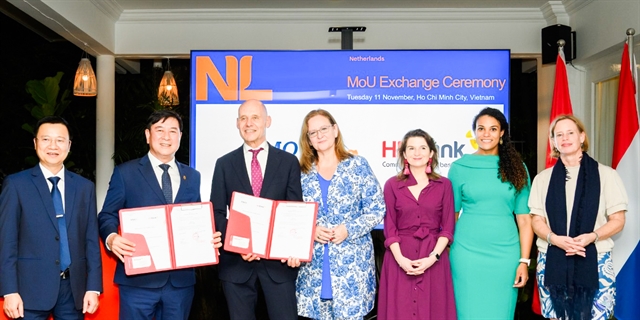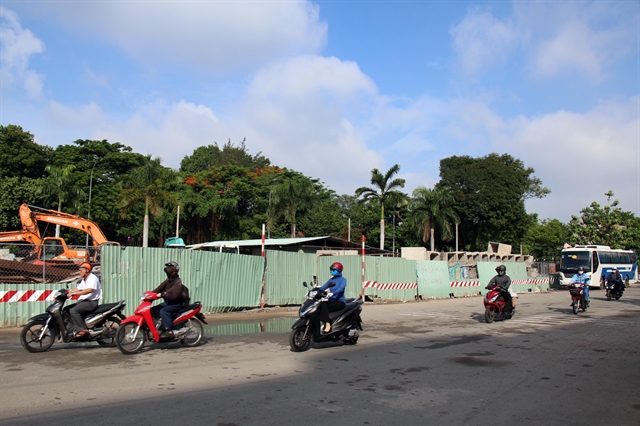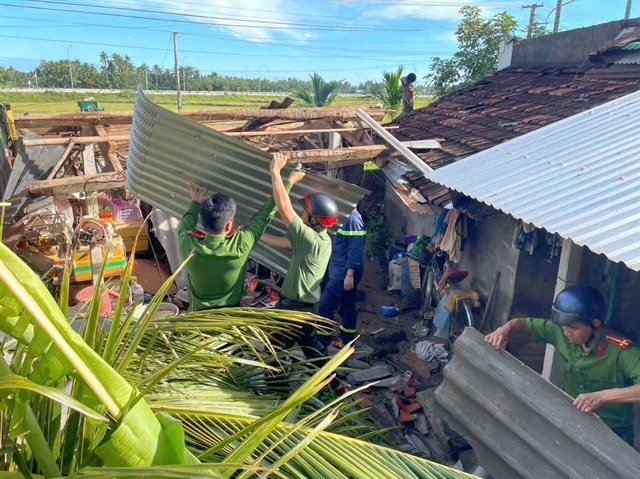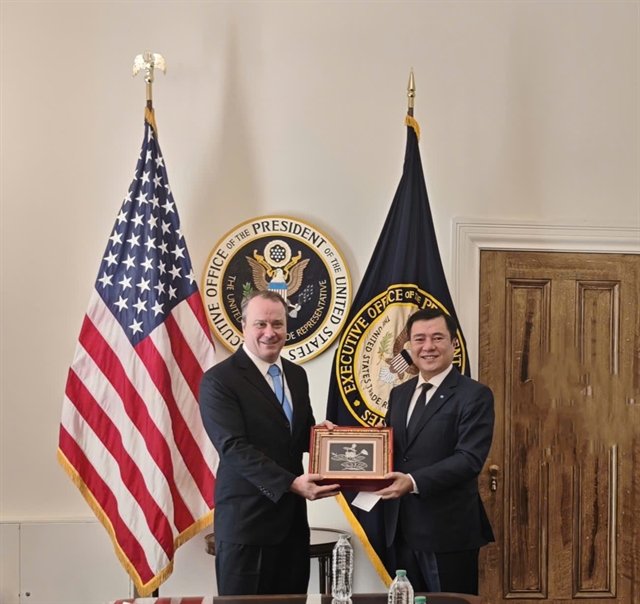

There are no other villages like Đông Cứu. It once supplied royal people with their special clothes for important ceremonies.
 |
| Soaring spirit: A dress used in the hầu đồng ritual made by Đông Cứu artisans. Photo An Thành Đạt |
There are no other villages like Đông Cứu.
It once supplied royal people with their special clothes for important ceremonies.
In modern times, villagers are once again making these clothes, which have become fashionable.
They make them the old way. Often, this takes along time.
By Hà Nguyễn
Đông Cứu has a unique claim to fame in Viet Nam.
It is the only craft village that used to supply dresses for kings, lords and courtiers to wear for rituals.
That was in the past, of course. It has always had another skill to bank on, that of embroidery, but it has still kept the unique tradition alive by producing items for hầu đồng, or the spirit medium.
The rituals were recognized by the UN cultural agency UNESCO as an intangible heritage of humanity last December.
Located on the banks of the Nhuệ River in Hà Nội’s Thường Tín District, Đông Cứu has been famous for the embroidery that is used in traditional festivals.
Vũ Văn Giỏi, 58, an embroidery artisan, says since becoming the “fashion capital” for hầu đồng nearly four decades ago, almost all the villagers have entered the profession because “our customers are increasing, particularly during the first three months of the lunar calendar.”
“To meet increasing demand, we have to use an embroidery machine, but many customers specifically order handmade items because they are more genuine and attractive,” he says.
He insists that fashion plays an important role in the success of a hầu đồng ceremony. “Beautiful attireand jewellery help mediums and the audience feel more cheerful and enthusiastic.”
Giỏi also says that although they have many designs, embroiderers have to strictly obey design models, colours and accompanying costumes. For example, clothes of the king should always be in yellow and embroidered with dragons to symbolize his supreme rank.
“Our village has many skilled workers; they can embroider very well-detailed models from the smallest pieces. For example, they can embroider a dragon to make it look real.”
Giỏi says there are five basic colours used: green, red, white, yellow and deep blue. When other colours are needed, the thread has to be dyed.
Nguyễn Thế Dụ, 62, an embroidery artisan, says his family typically uses natural methods to dye the thread. This involves boiling the bark of a tree (he wanted to keep the tree’s name a secret) and dipping the thread in this liquid for 10 minutes.
“Đông Cứu workers have skilled hands, they can infuse a fresh spirit into a design, giving it its own soul and personality,” says 80 years old Bùi Thị Lụa. She says she strictly controls the quality of each item made by her family members and workers.
A high quality item should have a regular thread line with a soft embroidery line. “Even the shoes and hats for mediums have to be carefully embroidered,” Lụa says.
The technique of combining thread colours in embroidery is also very important in creating a beautiful item, and this affirms the skills of a worker, she says.
Many embroidery families sign contracts to supply items to shops in Hàng Quạt Street in Hà Nội’s Old Quarter, while others sign orders directly with customers, says Lụa.
The price of a costume embroidered carefully will be 10 times (about VND3-4 million each) that of a machine-made one, she adds.
It needs 15-20 days to make a set of hầu đồng ritual dresses, but for highly sophisticated items, a set will take several months. A simple pair of shoes needs 3-5 days of work, while restoring a set of costumes could take a year.
“My family produces quick handmade items for wholesale traders, and we can earn a profit of VNĐ50-60 million a month,” Lụa says, adding that so far this year, her goods have sold very well.
People from everywhere in the country and even abroad, particularly overseas Vietnamese, come to the village to buy its goods.
“I’ve received orders for the next two years,” Lụa says, noting that the job has helped many households in the village build spacious houses and buy luxury cars.
Trần Thị Mai, a cultural official in Thường Tín District, says the village now has more than 40 embroidery workshops, employing hundreds of workers including many young ones.
“Almost all my villagers are happy, because after several hundred years, they are still able to preserve the craft that is fast developing now.
Many young people in the village have joined the trade, because they can earn as much as VNĐ8-10 million per month,” says Mai.
Trương Thị Mẫn, a 11th grader who learned the job from her mother since she was four, has become a skilled worker.
“I can teach the embroidery technique to younger ones,” she says.
Nguyễn Đắc Bảy, of the Đông Cứu Embroidery Association, says more than 30 artisans in the village can teach the job to other villagers and people from other places, including those with disabilities.
Humble beginnings
It is said that Lê Công Hành (1606-1661) was the patron saint of this craft village. He learned the job after being assigned to work as envoy to a foreign country and taught the embroidery technique to Đông Cứu and surrounding villages.
Village elders say the tools used were quite simple, just needles, embroidery frames of different shapes, and a few other accessories.
Đông Cứu artisans began embroidering with gold and silver threads after they were invited by Nguyễn Kings to the Royal Citadel in Huế to set up a group specializing in decorating royal costumes.
Now, they use metallic-coloured threads to create similar effects for the dresses they produce.
“Thanks to UNESCO’s recognition of hầu đồng, many old costumes that were thought lost have been restored by Đông Cứu artisans.
The village is focusing on making items to supply to traditional festivals and religious ceremonies at temples and pagodas,” Bảy says.
He says more than 100 households in the village have set up their own workshop and 90 per cent of all the families are engaged in embroidery or supplying other items for rituals and festivals.
The village’s trade was recognised as a national intangible heritage last November.
Bảy says the recognition was a great encouragement for Đông Cứu people to preserve the traditional trade of their ancestors.
“We are planning to make our village a tourism destination.” -- VNS
GLOSSARY
Đông Cứu has a unique claim to fame in Viet Nam.
A claim to fame is a reason for being regarded as unusual or noteworthy.
It is the only craft village that used to supply dresses for kings, lords and courtiers to wear for rituals.
A courtier is an adviser to a king or a queen.
A ritual is a ceremony that follows a certain procedure.
That was in the past, of course. It has always had another skill to bank on, that of embroidery, but it has still kept the unique tradition alive by producing items for hầu đồng, or the spirit medium.
A skill is a way of making or doing things that usually requires special training.
To bank on something, in this case, means to rely on it.
Embroidery is a way of sewing that involves making patterns on material.
The rituals were recognized by the UN cultural agency UNESCO as an intangible heritage of humanity last December.
Something that is intangible does not exist as something physical and therefore cannot be touched.
Things that are considered to be heritage are passed down in families and communities over generations and give their members a sense of pride and belonging.
Humanity means the sense of being human.
Vũ Văn Giỏi, 58, an embroidery artisan, says since becoming the “fashion capital” for hầu đồng nearly four decades ago, almost all the villagers have entered the profession because “our customers are increasing, particularly during the first three months of the lunar calendar.”
An artisan is somebody who has skills that involve working with his or her hands.
A decade is a period of ten years.
“To meet increasing demand, we have to use an embroidery machine, but many customers specifically order handmade items because they are more genuine and attractive,” he says.
Demand is a measure of how much something is wanted.
“Beautiful attire and jewellery help mediums and the audience feel more cheerful and enthusiastic.”
Attire means clothing.
For example, clothes of the king should always be in yellow and embroidered with dragons to symbolize his supreme rank.
Symbolise means to be a symbol of something.
Supreme rank means being a very important and powerful person.
When other colours are needed, the thread has to be dyed.
A thread is a piece of cotton that is woven into a piece of clothing.
When something is dyed it is made to look a different colour.
“Đông Cứu workers have skilled hands, they can infuse a fresh spirit into a design, giving it its own soul and personality,” says 80 years old Bùi Thị Lụa.
To infuse a fresh spirit into the design means to fill the design with a fresh spirit.
The technique of combining thread colours in embroidery is also very important in creating a beautiful item, and this affirms the skills of a worker, she says.
A technique is a way of carrying out a particular task.
Many embroidery families sign contracts to supply items to shops in Hàng Quạt Street in Hà Nội’s Old Quarter, while others sign orders directly with customers, says Lụa.
A contract is a deal.
It needs 15-20 days to make a set of hầu đồng ritual dresses, but for highly sophisticated items, a set will take several months.
Sophisticated means having world experience and knowledge of fashion and culture.
A simple pair of shoes needs 3-5 days of work, while restoring a set of costumes could take a year.
Restoring means fixing something up so that it becomes as good as it was before it became ruined.
“I’ve received orders for the next two years,” Lụa says, noting that the job has helped many households in the village build spacious houses and buy luxury cars.
Spacious houses are large houses with lots of room.
“Almost all my villagers are happy, because after several hundred years, they are still able to preserve the craft that is fast developing now.
To preserve something means to keep it as it was when it was at its best.
Nguyễn Đắc Bảy, of the Đông Cứu Embroidery Association, says more than 30 artisans in the village can teach the job to other villagers and people from other places, including those with disabilities.
People with disabilities have problems with one or other parts of their bodies and therefore are not able to function in certain ways without help.
It is said that Lê Công Hành (1606-1661) was the patron saint of this craft village.
A patron saint is someone who guides or protects a person or a place.
Village elders say the tools used were quite simple, just needles, embroidery frames of different shapes, and a few other accessories.
An accessory is something that can be added to something else in order to make it more useful or attractive.
The village is focussing on making items to supply to traditional festivals and religious ceremonies at temples and pagodas,” Bảy says.
Focussing on something means paying lots of attention to it.
Bảy says the recognition was a great encouragement for Đông Cứu people to preserve the traditional trade of their ancestors.
Your ancestors are your parents, grandparents, great grandparents and so on.
“We are planning to make our village a tourism destination.”
A destination is a place people travel to.
WORKSHEET
State whether the following sentences are true, or false
© Duncan Guy/Learn the News/ Viet Nam News 2017
1. False; 2. True; 3. True;4. False; 5. True.




